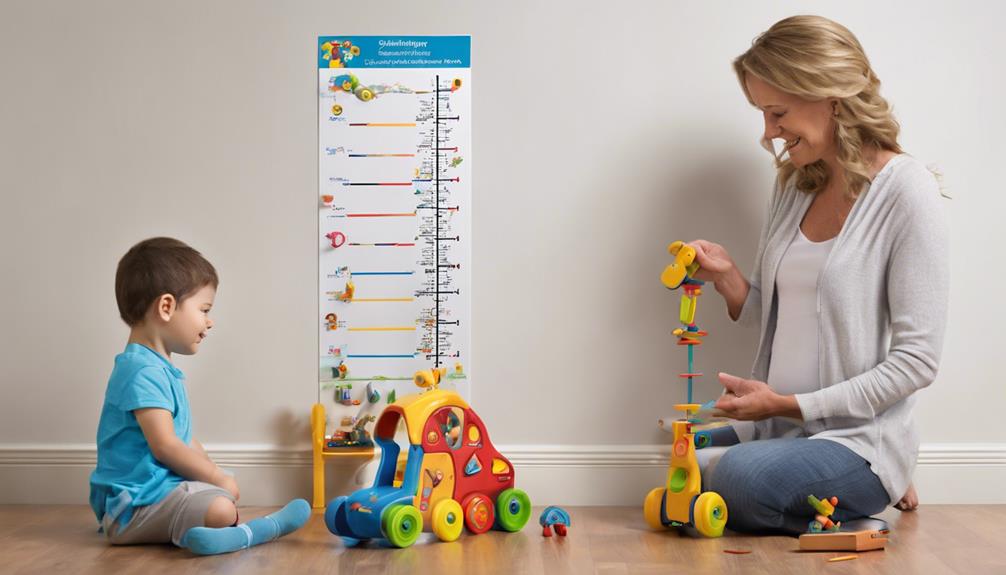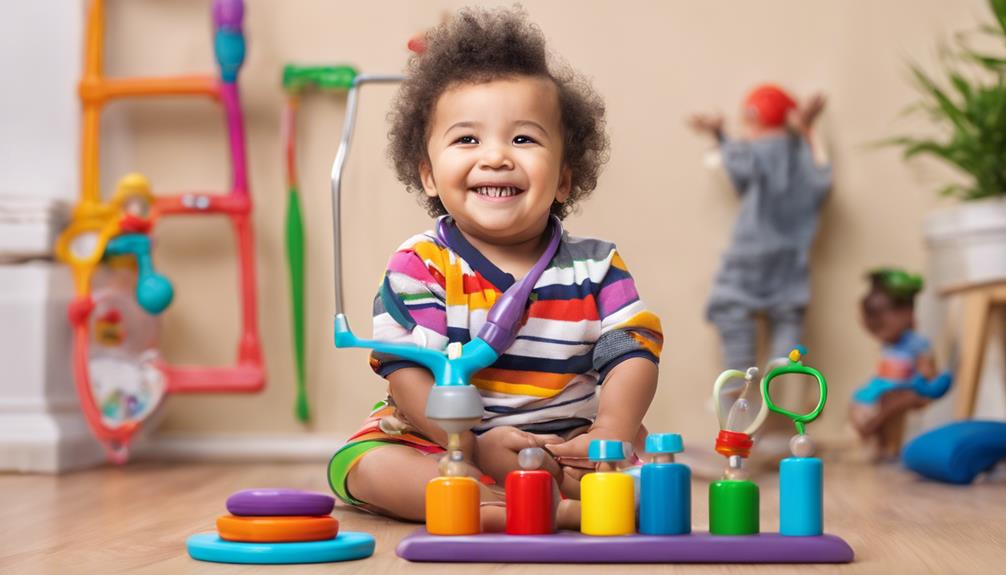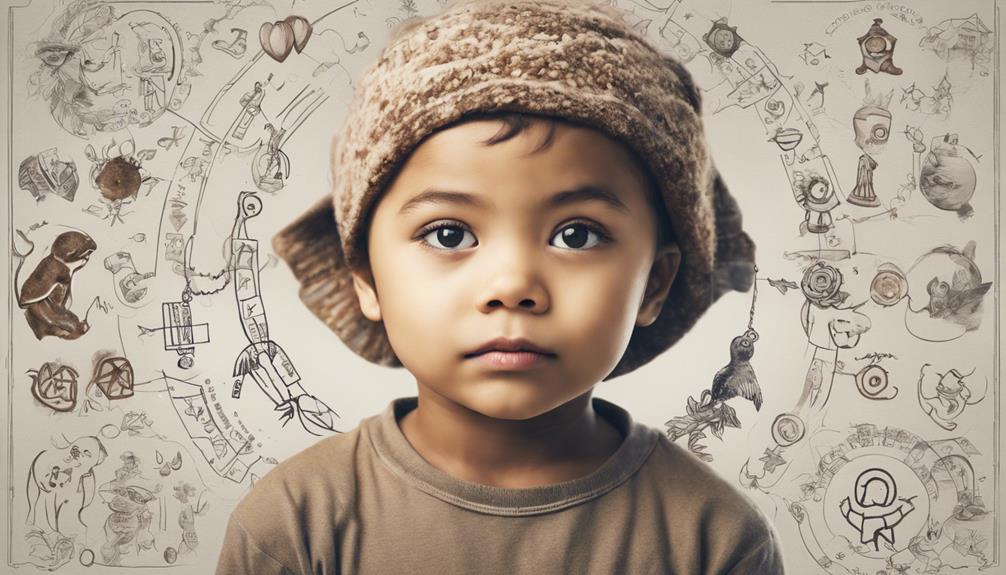As busy bees buzzing around, we often find ourselves pondering over the question: how do we monitor children's development progress?
The journey of understanding a child's growth involves a blend of keen observation, thoughtful questioning, and utilizing the right assessment tools.
But what are the key factors to pondering when setting on this enlightening expedition?
Join us as we unravel the mysteries behind effectively tracking children's development and fostering their potential for a brighter tomorrow.
Key Takeaways
- Actively track cognitive, emotional, and social development.
- Evaluate problem-solving, language skills, and emotional regulation.
- Encourage social interactions and monitor milestones.
- Use tools like ASQ and involve caregivers for comprehensive monitoring.
Importance of Developmental Monitoring
In monitoring children's development, we actively track their progress to identify delays early and guarantee prompt intervention, aiming to enhance outcomes in various developmental domains. Developmental monitoring plays an important role in detecting potential issues that could affect a child's overall growth and well-being. By observing milestones in playing, learning, speaking, behaving, and moving, we can pinpoint areas that may require extra attention and support.
Parents, caregivers, and healthcare providers are essential partners in this process, as they have the closest interactions with the child and can provide valuable insights into their development. Collaborating with professionals when milestones aren't met ensures that children receive the necessary interventions to address any delays effectively.
Early identification through developmental monitoring is particularly important, given that around 1 in 6 children in the US have developmental disabilities that could benefit from timely intervention. By staying vigilant and proactive in monitoring a child's progress, we can help pave the way for better developmental outcomes.
Tracking Cognitive Development Progress

Observing children's problem-solving skills, memory retention, language development, and understanding of concepts provides valuable insights into tracking their cognitive development progress. Monitoring cognitive milestones involves noting advancements in logical reasoning, attention span, perception, and processing of information. By evaluating their ability to solve puzzles, comprehend stories, follow instructions, and engage in imaginative play, we can gauge their cognitive growth.
| Milestones | Examples |
|---|---|
| Logical Reasoning | Solving puzzles, understanding cause and effect |
| Attention Span | Concentrating on tasks, following directions |
| Perception | Recognizing patterns, interpreting visual stimuli |
| Processing of Information | Understanding and responding to information |
Tracking cognitive development progress also entails observing improvements in attention, memory, problem-solving, and language skills as children mature. By witnessing how they interact with their surroundings, utilize tools, and engage in creative thinking, we gain valuable insights into their cognitive journey.
Evaluating Emotional Growth in Children

Shifting from tracking cognitive development progress, evaluating emotional growth in children involves closely observing how they express and regulate their emotions in various situations. Monitoring children's emotional development allows us to assess their ability to interact with others, handle conflicts, and cope with stress.
By paying attention to these aspects, we can identify important behaviors such as empathy, kindness, and emotional resilience. It's important to recognize and encourage these behaviors as they indicate healthy emotional growth. Additionally, tracking emotional progress helps us spot any potential issues early on, providing the necessary support and guidance to address them effectively.
Social Development Monitoring Strategies
To effectively monitor social development in children, we prioritize encouraging social interactions and play as foundational support mechanisms. By tailoring social interactions and accommodations to suit each child's unique needs, we can create a supportive environment that fosters healthy social behaviors. Monitoring social interactions during group activities and free play allows us to observe and track progress in developing essential social skills.
Utilizing observations and checklists enables us to gather valuable insights into children's social development. These tools help us identify areas where children may need additional support and interventions. Collaboration with parents, teachers, and caregivers is key in implementing a holistic and collaborative approach to social development monitoring. By working together, we can guarantee that children receive the necessary guidance and resources to thrive socially.
Tools for Development Progress Tracking

Utilizing modern technology and standardized questionnaires, we streamline the process of tracking children's developmental progress with precision and efficiency. Monitoring a child's developmental progress involves evaluating milestones in various domains such as playing, learning, speaking, behaving, and moving. Standardized questionnaires like the Ages and Stages Questionnaires (ASQ), Parents' Evaluation of Developmental Status (PEDS), and Modified Checklist for Autism in Toddlers (M-CHAT) are valuable tools for evaluating these different areas and identifying potential issues early on. Involving parents, grandparents, and caregivers in the monitoring process is essential for early intervention and support. If any concerns arise regarding a child's developmental milestones, discussing these with the child's doctor can lead to timely interventions and appropriate guidance. By employing a combination of technology, questionnaires, and involving caregivers, we can make sure that children receive the necessary support and interventions to reach their full potential.
| Standardized Questionnaires | Domains Evaluated | Benefits |
|---|---|---|
| ASQ | Multiple | Early Intervention |
| PEDS | Developmental Areas | Identifying Potential Issues |
| M-CHAT | Autism Spectrum | Timely Interventions |
Frequently Asked Questions
How Can Growth and Development Be Monitored in Children?
In observing children's growth and development, we track milestones in play, learning, speech, behavior, and movement. Using tools like the CDC Milestone Tracker App aids in monitoring progress. Involving caregivers provides a holistic view.
How Do We Measure the Development of the Child?
We measure a child's development by tracking milestones in language, motor skills, social interaction, and adaptive skills. Observing behavior, interactions, and achievements offers valuable insights. Using standardized tools like ASQ, PEDS, and M-CHAT helps identify potential delays.
Which Skills Are Included When Monitoring a Child's Development?
Evaluating a child's development involves gauging language, motor skills, social interactions, cognitive abilities, and adaptive behaviors. Observing communication skills, physical movements, interactions, problem-solving abilities, and daily living skills is vital. Tracking milestones like babbling, crawling, eye contact, imitating actions, and using objects is key.
How Do You Monitor Developmental Milestones?
Noticing small changes in behavior or mastering new skills can be exciting signs of growth. We observe and document milestones like first steps, first words, and social interactions. Tracking these moments helps us understand children's development progress.
Conclusion
In our journey of monitoring children's development progress, we're like gardeners tending to a delicate seedling. Just as we carefully observe, nurture, and support the growth of a plant, we must do the same for our children.
By paying attention to their milestones and addressing any concerns early on, we can help them blossom into their fullest potential.
Let's continue to cultivate a supportive environment that fosters their growth and development.










